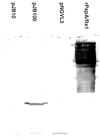Genetic immunization with the region encoding the alpha-helical domain of PspA elicits protective immunity against Streptococcus pneumoniae
- PMID: 11500417
- PMCID: PMC98657
- DOI: 10.1128/IAI.69.9.5456-5463.2001
Genetic immunization with the region encoding the alpha-helical domain of PspA elicits protective immunity against Streptococcus pneumoniae
Abstract
Pneumococcal surface protein A (PspA) is a pneumococcal virulence factor capable of eliciting protection against pneumococcal infection in mice. Previous studies have demonstrated that the protection is antibody mediated. Here we examined the ability of pspA to elicit a protective immune response following genetic immunization of mice. Mice were immunized by intramuscular injections with a eukaryotic expression vector encoding the alpha-helical domain of PspA/Rx1. Immunization induced a PspA-specific serum antibody response, and immunized mice survived pneumococcal challenge. Survival and antibody responses occurred in a dose-dependent manner, the highest survival rates being seen with doses of 10 microg or greater. The ability of genetic immunization to elicit cross-protection was demonstrated by the survival of immunized mice challenged with pneumococcal strains differing in capsule and PspA types. Also, immunized mice were protected from intravenous and intratracheal challenges with pneumococci. Similar to the results seen with immunization with PspA, the survival of mice genetically immunized with pspA was antibody mediated. There was no decline in the level of protection 7 months after immunization. These results support the use of genetic immunization to elicit protective immune responses against extracellular pathogens.
Figures






Similar articles
-
Analysis of serum cross-reactivity and cross-protection elicited by immunization with DNA vaccines against Streptococcus pneumoniae expressing PspA fragments from different clades.Infect Immun. 2002 Sep;70(9):5086-90. doi: 10.1128/IAI.70.9.5086-5090.2002. Infect Immun. 2002. PMID: 12183557 Free PMC article.
-
Enhanced protective immunity against pneumococcal infection with PspA DNA and protein.Vaccine. 2006 Jul 17;24(29-30):5755-61. doi: 10.1016/j.vaccine.2006.04.046. Epub 2006 May 4. Vaccine. 2006. PMID: 16759765
-
PspA family fusion proteins delivered by attenuated Salmonella enterica serovar Typhimurium extend and enhance protection against Streptococcus pneumoniae.Infect Immun. 2009 Oct;77(10):4518-28. doi: 10.1128/IAI.00486-09. Epub 2009 Aug 17. Infect Immun. 2009. PMID: 19687204 Free PMC article.
-
Systemic and mucosal protective immunity to pneumococcal surface protein A.Ann N Y Acad Sci. 1996 Oct 25;797:118-26. doi: 10.1111/j.1749-6632.1996.tb52954.x. Ann N Y Acad Sci. 1996. PMID: 8993356 Review.
-
A Jack of All Trades: The Role of Pneumococcal Surface Protein A in the Pathogenesis of Streptococcus pneumoniae.Front Cell Infect Microbiol. 2022 Feb 2;12:826264. doi: 10.3389/fcimb.2022.826264. eCollection 2022. Front Cell Infect Microbiol. 2022. PMID: 35186799 Free PMC article. Review.
Cited by
-
Th17-Mediated Cross Protection against Pneumococcal Carriage by Vaccination with a Variable Antigen.Infect Immun. 2017 Sep 20;85(10):e00281-17. doi: 10.1128/IAI.00281-17. Print 2017 Oct. Infect Immun. 2017. PMID: 28717032 Free PMC article.
-
Analysis of serum cross-reactivity and cross-protection elicited by immunization with DNA vaccines against Streptococcus pneumoniae expressing PspA fragments from different clades.Infect Immun. 2002 Sep;70(9):5086-90. doi: 10.1128/IAI.70.9.5086-5090.2002. Infect Immun. 2002. PMID: 12183557 Free PMC article.
-
Genetic diversity of PspA types among nasopharyngeal isolates collected during an ongoing surveillance study of children in Brazil.J Clin Microbiol. 2006 Aug;44(8):2838-43. doi: 10.1128/JCM.00156-06. J Clin Microbiol. 2006. PMID: 16891500 Free PMC article.
-
Caseinolytic protease: a protein vaccine which could elicit serotype-independent protection against invasive pneumococcal infection.Clin Exp Immunol. 2009 Apr;156(1):52-60. doi: 10.1111/j.1365-2249.2008.03866.x. Epub 2009 Feb 11. Clin Exp Immunol. 2009. PMID: 19220325 Free PMC article.
-
Immunization with PspA incorporated into a poly(ethylene oxide) matrix elicits protective immunity against Streptococcus pneumoniae.Clin Vaccine Immunol. 2007 Jun;14(6):789-91. doi: 10.1128/CVI.00082-07. Epub 2007 Apr 25. Clin Vaccine Immunol. 2007. PMID: 17460113 Free PMC article.
References
-
- Abbas A K, Murphy K M, Sher A. Functional diversity of helper T lymphocytes. Nature. 1996;383:787–793. - PubMed
-
- Arnold K E, Leggiadro R J, Breiman R F, Lipman H B, Schwartz B, Appleton M A, Cleveland K O, Szeto H C, Hill B C, Tenover F C, Elliott J A, Facklam R R. Risk factors for carriage of drug-resistant Streptococcus pneumoniae among children in Memphis, Tennessee. J Pediatr. 1996;128:757–764. - PubMed
-
- Breiman R F, Butler J C, Tenover F C, Elliott J A, Facklam R R. Emergence of drug-resistant pneumococcal infections in the United States. JAMA. 1994;271:1831–1835. - PubMed
-
- Briles D E, Hollingshead S K, Swiatlo E, Brooks-Walter A, Szalai A, Virolainen A, McDaniel L S, Benton K A, White K, Prellner K, Hermansson A, Aerts P C, van Dijk H, Crain M J. PspA and PspC: their potential for use as pneumococcal vaccines. Microb Drug Resist. 1997;3:401–408. - PubMed
Publication types
MeSH terms
Substances
Grants and funding
LinkOut - more resources
Full Text Sources
Other Literature Sources
Medical

